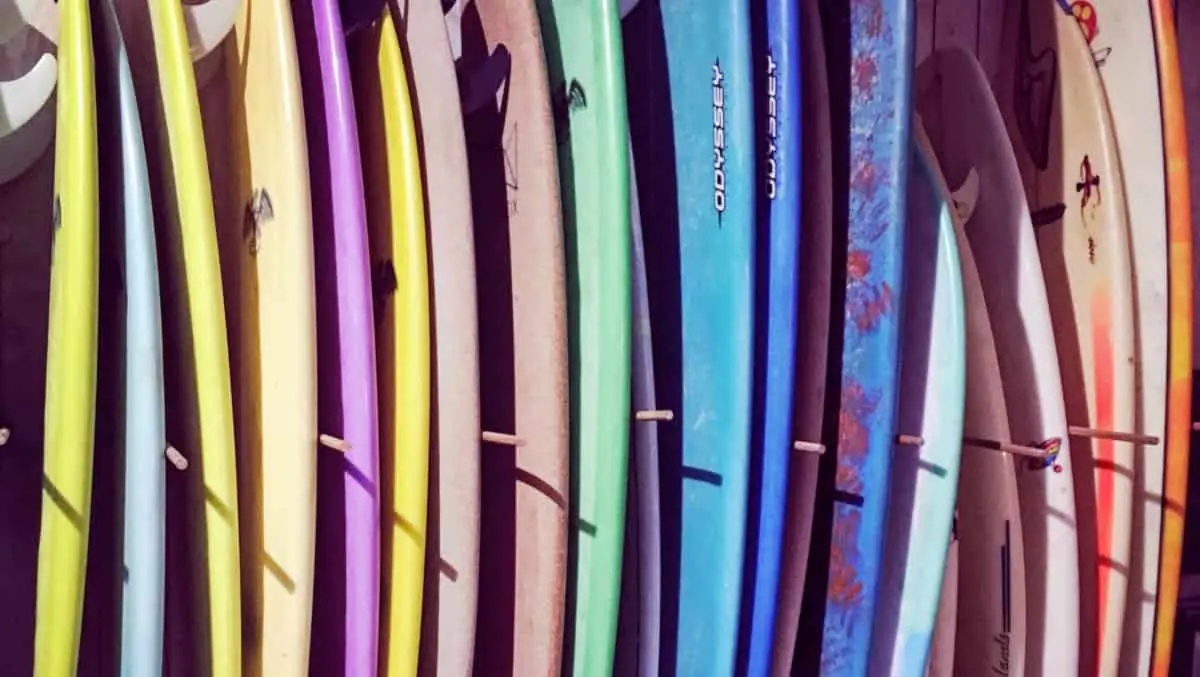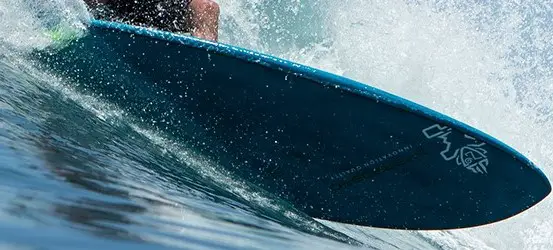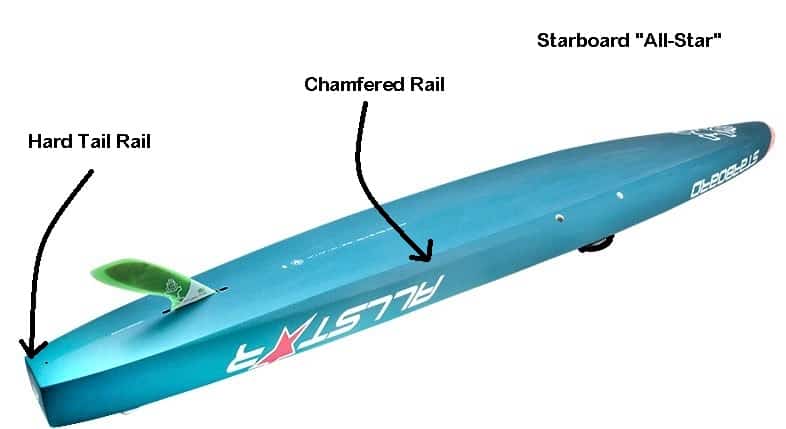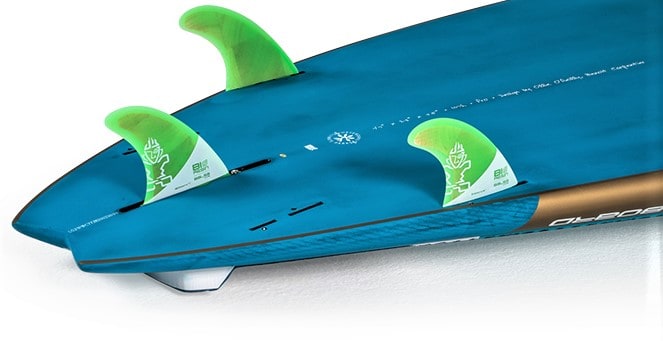Rails are the “edges” around a paddle board including the nose and tail. Rails are “shaped” by paddle board builders to affect performance.
Water wraps around the surface of the rails when the sup is pushed against the water. The shape of the rail determines the amount of drag or release the board has in the water. So the shape of the rail is key to how your board moves through the water.
How a rail is shaped will have a direct affect on the performance of a paddle board. Paddle boards have many different rail shapes depending on the use of the paddle board. The more performance paddling you do the more important rail shape becomes.
Rails make a huge difference when racing or surfing
Rails have the most affect on surf and race sup performance. If you own an “all-around” paddle board for family fun the rail shape is not as critical.
We will look at these three basic aspects of rail design:
1. Rail Edge Type
2. Rail Volume
3. Rail Foil Shape
1. Rail Edge Type
You can categorize rail design into two basic types. Hard rails and soft rails. Hard rails (also called a down rail) are squared off with a corner or edge where the board meets the water. Soft rails are rounded with no edges or corners.

Soft Rails (round)
With no edge water flows freely up the sides of a soft rail. In fact, water flows up and wraps around (grabs) the sides of a soft rail creating drag. Drag, of course, slows the paddle board down. Soft rails are full (thick) and have more volume giving a board more “float”.
Hard Rails (with an edge)
Sometimes called a down rail. A hard rail has an edge where the board meets the water. The edge will abruptly release the water flow from the board reducing drag. So hard rails are best for speed. Hard rails tend to be thinner, carrying less volume and allowing the board to sink deeper in the water.
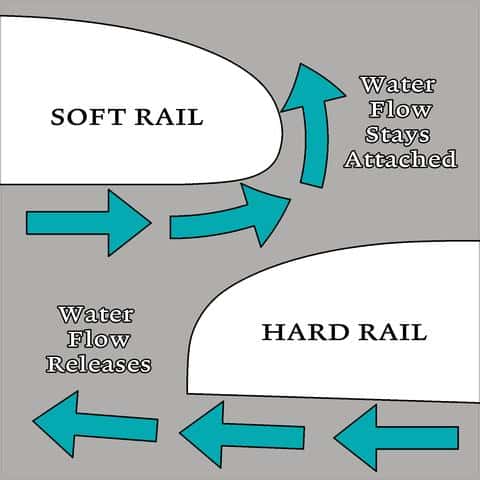
Other rail edge types used on paddle boards
Tucked Under Rails (between hard and soft)
“Tucked” adds more curve below the bottom line of the rail. “60/40 tucked under rails” are a compromise between hard and soft. A “Tucked” rail doesn’t have a real edge but it is still more pointed than a soft rail.
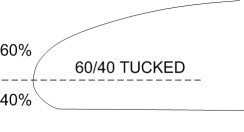
Chine Rails (hard with a chamfer)
Chine rails have chamfered or beveled edges. The chamfer increases speed. The Starboard All Star Racing SUP has a wide chamfer in the center of the board that reduces drag. Notice that hard edge on the tail of the All Star for maximum water release.
2. Rail Volume (thickness)
Rails are shaped to different thicknesses. Volume is the overall thickness of the rail.
Full, thick rails hold more volume and are harder to push down into the water. Thicker rails have more area for water to “grab”.
Thin rails carry less volume and dig deeper into the water. Thinner rails have less area for the water to grab ahold.
Rails will vary in thickness, from nose to tail, depending on the amount of float needed for best performance. Surfing sups will be full (thick) near the center and thinner near the tail and nose. Racing sup rails will be the same thickness from nose to tail. Inflatable sup rails can only have one thickness from nose to tail.
3. Rail Foil Shape (distribution of volume)
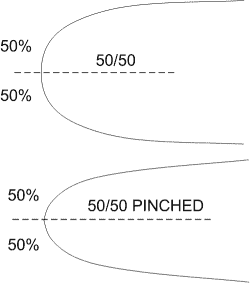
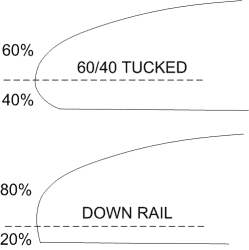
50/50
The volume on a 50/50 rail is equally distributed top to bottom. 50/50 rails are soft (round) rails. 50/50 rails can be full or thin (pinched). All inflatable paddle boards have 50/50 rails.
60/40
60/40 rails can be round (soft) or hard (have an edge). 60/40 Tucked adds more curve to the rail below the 40% line.
80/20 Rail
80/20 rails are hard rails with an edge. They are thinner and dig deeper into the water.
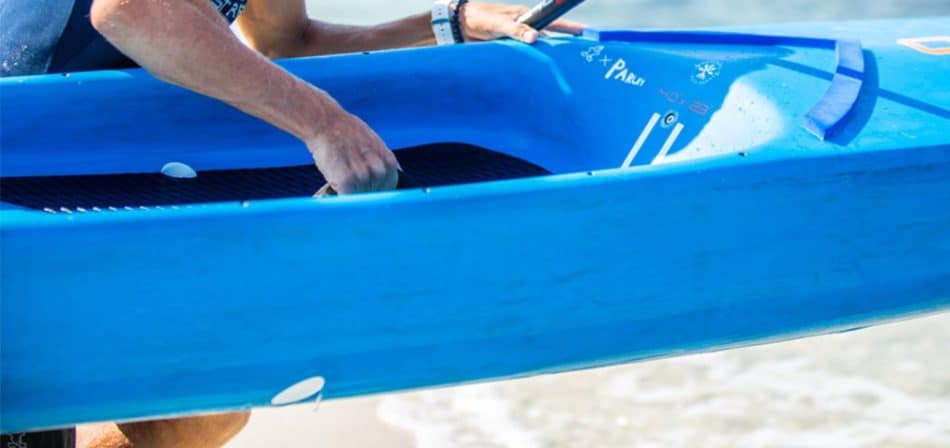
Rails and Your Paddle Board
Inflatable Paddle Boards
The rails on an inflatable paddle board cannot be shaped. So all inflatables have soft (round) rails with a 50/50 foil. This is one reason inflatables are not as responsive or fast as hard/epoxy paddle boards.
Rail volume will depend on the board thickness. While 6″ is the most common rail size, some inflatables are 4″ thick.
Because of their rail shape inflatables have arching, wide turns when surfing waves. You can’t make fast, dynamic turns on a wave with an inflatable. While you can ride small waves with an inflatable you can’t really do any performance maneuvers. So serious sup surfers always end up with a hard/epoxy board.
On the positive side a round rail is more forgiving and works okay surfing weak, mushy waves. So a beginner might have more fun surfing an inflatable.
If you want to surf an inflatable sup look for a 4″ thickness for a bit better performance. The thinner rail will “dig” a bit deeper in the wave than a 6″ thick iSUP. Also look for an inflatable with tail rail runners.
Tail Rail Runners
Some inflatable paddle board brands are adding rail runners on the tail of their surf and race models. This runner creates an edge that releases water from the tail reducing drag. The edge also helps making turns when surfing an inflatable. When stepping on the tail for a turn you get more grip and drive.
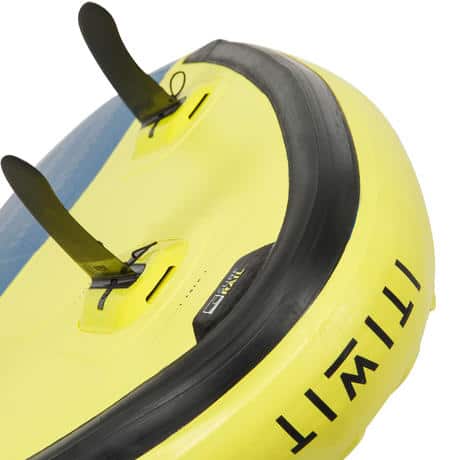
Fiberglass/Epoxy (hard) SUPs
Racing and Long Distance Touring SUPs
Rail shape and design has a big effect on speed. Racing and long distance touring sup rails have a sharp hard edge to release water quickly and reduce drag.
Racing sups have tall straight boxy rails (high volume) making them more stable despite their narrow width.
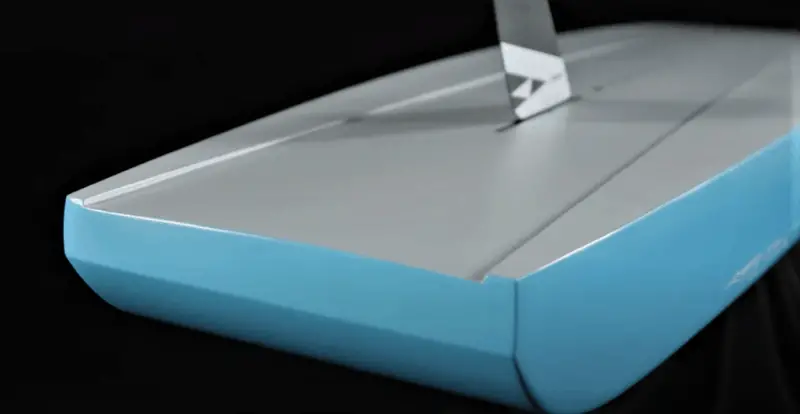
The tail of a racing board has the sharpest rail edge. The water flowing underneath the board needs to be released quickly at the tail with a sharp edge.
If you have a round rail at the back of the board (like an inflatable) the water will wrap around the tail (grabbing it) and slow it down.
The sides of a racing rail also has a sharp edge and may have a chamfer. A chamfer or chine reduces the planing surface of the board to increase speed and glide. Chines also tend to deflect water away from the board.
Racing sup rails have the same thickness or volume from nose to tail. Racing rails are high volume.
Surfing SUPs
Fiberglass/epoxy paddle boards surf much better than inflatable boards. And the ability to shape the rail is the main reason they surf so much better. Rails determine buoyancy, speed and the board’s ability to perform radical maneuvers on a wave. Rails have a massive impact on sup surfing performance.
Surfing sups will have rails with a sharp edge for extra control and quick turns.
Surf sup rails are shaped full in the center and thin closer to the nose and tail. The rails are full near the feet to float the paddler. The rails on the nose and tail are thinner with more of an edge for cutting into the wave. There is a compromise on the rails of a surf sup between float or buoyancy and cutting ability .
A thinner rail allows the board to dig into the wave for greater control. Thin rails make a surf sup more sensitive and reactive to foot pressure. This increases drive and allows for dynamic aggressive turns. The lower volume on a thin rail allows the board to sit a bit lower in the water helping with stability.
Thin rails are good for advanced surfers on steep fast waves. But if the rails are too thin the board will not be able to float the paddler.
So heavier sup surfers may need a thicker rail for more float. If you are a beginner to sup surfing you may want a bit softer fuller rail that will be more forgiving. The extra volume will help you connect turns in weak mushy waves.

